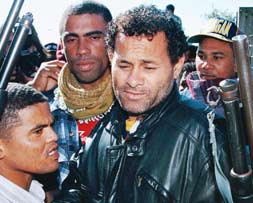
Rashied Staggie passes through a police blockade followed by fellow gang members in Cape Town, South Africa. Credit: AP Photo/Sasa Kralj |
South Africa: Gangs of Cape Flats
For more than 50 years, street gangs have been a defining part of life in the so-called “coloured” communities of the Cape Flats area of Cape Town, South Africa.
“Coloured” was one of four expressions used by South Africa’s former apartheid regime to characterize citizens, along with “Black,” “White,” and “Indian.” The word refers to mixed-race people, usually of some combination of European, black, Khoisan, Malay, Malagasy, and South Indian heritage. In 1950, the Group Areas Act dismantled a mixed-race area in central Cape Town, relocating residents to racially designated sections of Cape Flats — the infamous “dumping grounds of apartheid.” The move brought together young men who had previously lived in different communities, creating a sudden competition for limited resources and territory that facilitated the growth of gangs.
Under apartheid, black youths who may have found meaning in gang activities instead became involved in the struggle for liberation, but the coloured community did not have this outlet. As of 2003, the homicide rate within the coloured population was the highest in South Africa, and the Western Cape province, which includes Cape Town, had the highest crime and homicide rates in the country.
Many Cape Flats residents feel there is a limited police presence in their community, and that officers in the area often accept bribes from gangs and/or tip gang members off when they receive complaints. Rampant alcoholism, meanwhile, can be traced to the nearby vineyards, which historically employed members of the coloured community, and to the practice of paying laborers partly in wine — fostering violence, dysfunctional families, and fetal alcohol syndrome.
Most gang members are initiated between the ages of 13 and 15, and are immediately armed with guns. Younger members are expected to assume the front lines in confrontations, to prove their mettle to senior members. For some, membership may last until the age of 40 or 50.
The distinction between the real street gangs and the schoolchildren who simply imitate gang behavior can be blurry, but a few “name” gangs include: the Americans, the Junky Funky Kids, the Dixie Boys, and the Hard Livings Kids. The latter was led by the infamous Staggie twins, Rashied and Rashaad. Rashaad was killed in 1996 by a vigilante group called People Against Gangsterism and Drugs, but his brother, Rashied, or “Mad Dog,” is still at large.
Many of these street gangs are aligned with South Africa’s prison gangs, which are known as “the numbers.” There are three numbers gangs, each of which was founded to serve a specialized duty within the prison system: the 26s were charged with acquiring money, the 28s dedicated themselves to improving conditions within the prisons, and the 27s moderated disputes between the other two factions.
The command structure of the prison gangs is strictly hierarchical, like the military, whereas leadership of the street gangs is more informal. Street gang leaders tend to earn respect and status primarily through the strength of their personality, although this varies from gang to gang. The Hard Livings, for instance, operate by means of semi-democratic weekly meetings. Members show deference to the Staggie family, but do not otherwise rely on formal promotions. The Americans, however, are more closely aligned to the 26s prison gang and thus closely follow the 26s’ chain of command.
The gangs’ primary source of income is drug running, in particular crack cocaine, which is also closely associated with the prostitution trade. It can be a violent business. Armed violence also results from gang rivalries, and the easy availability of firearms can lead to deadly quarrels over girlfriends and perceived showings of disrespect. Indeed, gun violence is such an inescapable part of local life, many members say they are forced to join a gang for self-protection.
